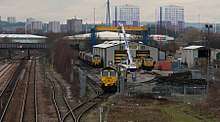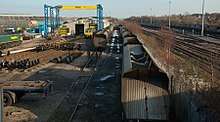Leeds Midland Road depot
 The view from Pepper Road north west across Leeds Midland Road Depot. The lines on the left head towards Leeds station. | |
| Location | |
|---|---|
| Location | Leeds, West Yorkshire |
| Coordinates | 53°46′30.8″N 1°31′40.1″W / 53.775222°N 1.527806°WCoordinates: 53°46′30.8″N 1°31′40.1″W / 53.775222°N 1.527806°W |
| OS grid | SE312310 |
| Characteristics | |
| Owner(s) | Freightliner (UK) |
| Operator(s) | Freightliner (UK) |
| Depot code(s) | FD[1] |
| Type | Freight locomotive |
| Roads | 9 |
| Rolling stock |
Class 66 Class 70 Class 90 |
| History | |
| Opened | July 2003 |
Leeds Midland Road depot is a locomotive and rolling stock maintenance facility located in Leeds, West Yorkshire, England. The site is just to the south-west of Leeds station on the line between Leeds and Castleford. It services the Heavy Haul and Intermodal freight locomotives for the Freightliner (UK) freight operations company (FOC). Although the facility is part of the same parent company, it is separate arm known as Freightliner Maintenance Limited (FML). Whilst it is primarily a diesel serving depot, it also maintains electric locomotives and wagons from the Freightliner fleet.
History
The £1.75 million site was opened in 2003 by London & North Western Railway (LNWR) as a maintenance facility[2][3] and was located on the former Balm Road sidings that had been used to offload quarry products.[4] LNWR were contracted to maintain up to 30 class 66 locomotives that worked in the Yorkshire area at the site, with heavier maintenance being carried out by Electro-Motive.[2] In 2006, Freightliner Maintenance Limited (FML) was formed and it then assumed control of operations at Leeds.[5] FML is a "free-standing subsidiary" of the Freightliner Group and was instituted when the number of locomotives and wagons the company leased or owned increased with an upsurge in traffic.[6] Besides being a central point for maintaining the class 66 and class 70 fleets, both classes are based from here and the facility undertakes wagon maintenance.[1]
The site has a total of nine roads;[note 1][7][8] the shed has two covered roads that have pits beneath them to allow access to the underside of wagons and locomotives, whilst the fuelling point also has two roads, but only one of these is covered. Outside of these, there are a further five roads for storage and maintenance.[9] A 25-tonne (28-ton) crane spans roads 3 and 4 to allow for wheelset changes on locomotives and wagons.[9]
As the site is 10 chains (660 ft; 200 m) north of Stourton Freightliner terminal,[8] locomotives in need of repair (or electric locomotives)[10] are often hauled dead-in-train (DiT) to Stourton and transferred to Midland Road for servicing or repair.[note 2][11][12] Locomotives on routine maintenance find their way to Midland Road by hauling scheduled services. Besides the container trains passing through Stourton to the south, many Heavy Haul trains run past the depot too, which makes switching locomotives easy and cost-effective.[13]

With the downturn in tonnages of coal moved by railfreight in the United Kingdom,[14] several examples of Class 70 locomotives have been stored on the non-maintenance sidings that border the running lines to the south.[15][16]
In November 2017, Freightliner opened up a new maintenance facility at Crewe Basford Hall that has taken on some of the work previously undertaken at Leeds Midland Road, particularly the electric locomotives as there is no overhead wire access into Midland Road.[8] The heavier maintenance work will still be carried at Leeds though.[17]
Notes
- ↑ Initially, under the 2003 LNWR contract, the site had fewer roads, but more have been added over the years
- ↑ It is not uncommon for locomotives from Crewe being hauled DiT from Crewe to Southampton (intermodal terminal) and then being hauled DiT from Southampton to Leeds Stourton intermodal terminal to avoid needing a separate path direct between Crewe and Leeds
References
- 1 2 Richardson, Dave (April 2018). "On Shed". Rail Express. No. 263. Horncastle: Mortons Media. p. 25. ISSN 1362-234X.
- 1 2 Shannon 2013, p. 105.
- ↑ Shannon, Paul (2006). Rail freight since 1968 : coal. Great Addington, Kettering: Silver Link. p. 19. ISBN 1-85794-263-9.
- ↑ Shannon, Paul (2008). Rail freight since 1968 : bulk freight. Great Addington, Kettering: Silver Link. p. 31. ISBN 978-1-85794-299-6.
- ↑ "Freightliner launches new subsidiary - Logistics Manager". logisticsmanager.com. 5 April 2006. Retrieved 14 May 2018.
- ↑ Shannon 2013, p. 104.
- ↑ Jacobs, Gerald (2006). Eastern (3 ed.). Bradford on Avon: TRACKmaps. p. 37. ISBN 0-9549866-2-8.
- 1 2 3 Brailsford, Martyn (2016). Railway Track Diagrams Book 2; Eastern (4 ed.). Frome: TRACKmaps. p. 36. ISBN 978-0-9549866-8-1.
- 1 2 Shannon 2013, p. 106.
- ↑ Bendall, Simon (December 2017). "News round-up". Rail Express. No. 259. Horncastle: Mortons Media. p. 95. ISSN 1362-234X.
- ↑ Harris, Nigel, ed. (2 July 2016). "Freightliner to overhaul fleet of class 90s' [sic] using component exchange". Rail Magazine. No. 804. Peterborough: Bauer Media. p. 34. ISSN 0953-4563.
- ↑ Bendall, Simon (September 2017). "Reprieve for stored Freightliner class 66s". Rail Express. No. 256. Horncastle: Mortons Media. p. 85. ISSN 1362-234X.
- ↑ Shannon 2013, p. 108.
- ↑ Clinnick, Richard (21 June 2017). "Coal's steep decline makes it a tough year for rail freight". Rail Magazine. No. 829. Peterborough: Bauer Media. p. 16. ISSN 0953-4563.
- ↑ Jackson, John (2017). Class 70 Locomotives (1 ed.). Stroud: Amberley Publishing. p. 3. ISBN 978-1-4456-7272-4.
- ↑ Jones, Ben (March 2018). "Freight Industry Concern at Government Diesel Ban". The Railway Magazine. Vol. 164 no. 1, 404. Horncastle: Mortons Media. p. 78. ISSN 0033-8923.
- ↑ Bendall, Simon (January 2017). "New Basford Hall TMD unveiling with remembrance naming". Rail Express. No. 248. Horncastle: Mortons Media. p. 15. ISSN 1362-234X.
Sources
- Shannon, Paul (2013). Freightliner. Surrey: Ian Allan. ISBN 978-0-7110-3688-8.
External links
| Wikimedia Commons has media related to Leeds Midland Road depot. |